Automation, digitalization, and diversity fueling Kamigo Plant's transformation and growth
**Toyota's Kamigo Plant Embraces Automation and Digitalization for Future-Ready Engine Production**
In a significant move towards manufacturing innovation, Toyota's Kamigo Plant, home to some of the company's most advanced engine production, has fully automated its piston subline, relying on robots to perform all tasks since its launch in January 2025. This transformation is part of Toyota's broader strategy to embrace automation, digitalization, and flexibility in its production processes.
The control center at the Kamigo Plant, a hub of collaboration between various departments including manufacturing engineering and quality control, plays a crucial role in addressing any difficulties that arise. This collaborative approach not only contributes to personnel development but also ensures swift problem-solving.
Team Leader Daisuke Saito at the Kamigo Plant/Shimoyama Plant Manufacturing Support Division is spearheading efforts to train robots to mimic the sense and instincts of human workers. Meanwhile, Senior Expert Norio Ito of Engine Manufacturing Section No. 23 emphasizes the importance of fundamental knowledge of equipment to resolve problems and determine true causes.
The Kamigo Plant, which began operations with state-of-the-art facilities in anticipation of making engines for the future, will continue to pursue labor-saving solutions on other lines as birthrates decline and young people show less interest in manufacturing jobs. The automation process at the Kamigo Plant has benefited from experience gained in the days when parts were assembled by hand.
Toyota's commitment to the Toyota Production System (TPS), with a strong emphasis on waste elimination and continuous improvement (kaizen), drives efficiency and is adapted to include new digital tools. Across Toyota's global operations, there is a push toward digital transformation, including the use of data analytics, AI-driven process optimization, and the development of new business domains such as "materials/data" and "safety/security."
These initiatives are expected to enhance operational visibility, improve quality control, and streamline maintenance, which would have direct implications for engine plants like Kamigo. Toyota has historically invested in automation to improve quality and reduce manual labor, but always in balance with the need for flexibility and human oversight.
The Kamigo Plant's future plans are likely to involve increasing automation, expanding digitalization, adopting flexible manufacturing systems, and focusing on talent and skills development. This means incorporating more advanced robotics and automated inspection systems, implementing real-time data tracking, predictive maintenance, and AI-powered analytics, and utilizing modular, adaptable production lines to support a mix of conventional and next-generation engines.
As automation and digitalization advance, the plant will likely invest in workforce upskilling to ensure employees can oversee and maintain complex automated and digital systems. The control center at Kamigo's Machining Plant No. 7, established in 2022, serves as a model for this approach, monitoring the operating conditions of 300 pieces of equipment on the plant's processing lines and using data visualization and equipment service to speed up problem-solving.
In conclusion, while specific plans for the Kamigo Plant have not been publicly detailed, Toyota's overall strategy emphasizes automation, digitalization, and flexibility, with a focus on continuous improvement and leveraging new digital technologies. These efforts are expected to ensure robust, future-ready engine production capabilities at Kamigo over the next decade.
- To align with Toyota's broader industrial strategy, the Kamigo Plant's automotive sector might eventually integrate advanced technology, such as AI-driven process optimization and data analytics, for efficient engine production.
- As Toyota continues to invest in the future-readiness of the Kamigo Plant, it may expand digitalization in the finance sector to optimize budget allocation for automation upgrades, transportation logistics, and technology integration.




